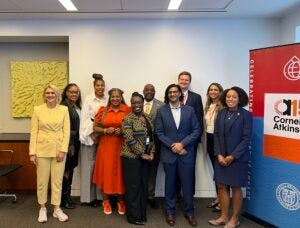
How data is powering community action on climate and health
5 Takeaways from New York Climate Week
By Sarah Vogel, Senior Vice President, Healthy Communities, EDF, Dr. Arnab Ghosh, Assistant Professor of Medicine, Weill Cornell Medical College and Stefanie Le, Writer, Data Smart Cities
Extreme weather is no longer a distant threat—it’s here. NASA reports that in the past year alone, the U.S. saw twice as many extreme weather events as the 2003–2020 average. Storms are stronger, heat waves last longer and wildfires spread faster.
At New York Climate Week, leaders from cities, universities and health organizations gathered to ask a pressing question: how can data help communities protect themselves? The panel, hosted by Cornell Atkinson Center for Sustainability and Environmental Defense Fund with the Community Data Health Initiative, City of Detroit, NYC Department of Health, NYU’s City Health program and the African American Mayors Association, emphasized the role of data in shaping health-focused climate solutions.
Here are five takeaways:
1. Data is the backbone of climate and health solutions
Mount Vernon Mayor Shawyn Patterson-Howard described how data revealed a stark divide in her city: tree-lined streets in the north are up to 7 degrees cooler than the south side, where residents face higher asthma rates and utility bills.
“We don’t have the luxury of ignoring climate because we live at its intersection,” she said. “With a 5 to 7 degree difference in heat because urban heat islands on the south side, tree lined streets on the north side. And what does that cause? More asthma, more pulmonary issues and higher utility bills for the people that can afford them the least.”
2. Cities must adapt and mitigate—at the same time
Detroit is turning vacant land into opportunity. With more than 124,000 empty parcels, the city is converting lots into urban farms.
“It can’t be one or the other,” said Trisha Stein, Detroit’s Chief Strategy Officer. “We’re protecting the vulnerable, stabilizing neighborhoods, growing locally sourced food and generating $23 million in health benefits.”
3. Climate and health aren’t political—they’re personal
Savannah Mayor Van Johnson put it bluntly:
“Seventy percent of our most intense storms have occurred since 2015. If we’re ever hit by a Category 3 hurricane, three-quarters of Savannah would be underwater.”
4. Lived experience shapes the strongest policies
Margot Brown of EDF reminded the audience that climate change doesn’t create inequities—it deepens them.
“Climate change is what we call a threat multiplier. So it doesn’t just create new challenges, it worsens the ones that we already face, especially for the most vulnerable populations. People already facing poverty or racism are hit first and worst. That’s unfair—and avoidable.”
5. Leaders don’t choose their crises—climate chooses for them
Representative Maxine Dexter (OR-03) recalled Oregon’s devastating 2020 wildfires, which burned more than a million acres. The smoke spread far beyond the fire line, endangering firefighters and residents alike.
“We must act with urgency and care,” she said. “The smoke literally goes where the wind blows it. Wildland firefighters have been out there with bandanas over their faces, fighting for generations. You don’t see mainland firefighters doing that anymore and we need that for our wildland firefighters.”
Keep Moving Forward
The message from New York Climate Week was clear: science and data must guide climate policy. As Representative Dexter put it,
“We should be depending on science to make policy. Citizens must demand investment in research and data collection.”












